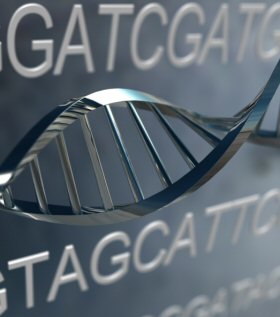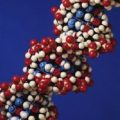
Adenine, thymine, guanine and cytosine – the A,T,G and C that make up the DNA code. But these 4 letters are not the whole story. The rise of epigenetics in the past decade has drawn attention to a fifth nucleotide, 5-methylcytosine (5-mC), that sometimes replaces cytosine in the famous DNA double helix to regulate which genes are expressed. And now, there’s a sixth. Publishing their findings in Science, Rockefeller University researchers reveal an additional character in the mammalian DNA code, opening an entirely new front in epigenetic research.
The work, conducted in Nathaniel Heintz’s Laboratory of Molecular Biology at The Rockefeller University, suggests that a new layer of complexity exists between our basic genetic blueprints and the creatures that grow out of them. “This is another mechanism for regulation of gene expression and nuclear structure that no one has had any insight into,” says Heintz. “The results are discrete and crystalline and clear; there is no uncertainty. I think this finding will electrify the field of epigenetics.”
By themselves, a creature’s genes cannot explain the vast differences in complexity among worms, mice, monkeys and humans, all of which have roughly the same amount of genetic material. Scientists have found that these differences arise in part from the dynamic regulation of gene expression rather than the genes themselves. Epigenetics, a relatively young and very hot field in biology, is the study of nongenetic factors that manage this regulation.
Some regional DNA methylation occurs in the earliest stages of life, influencing differentiation of embryonic stem cells into the different cell types that constitute the diverse organs, tissues and systems of the body. Recent research has shown, however, that environmental factors and experiences, such as the type of care a rat pup receives from its mother, can also result in methylation patterns and corresponding behaviors that are heritable for several generations. Thousands upon thousands of scientific papers have focused on the role of 5-methylcytosine in development.
The discovery of a new nucleotide may make biologists rethink their approaches to investigating DNA methylation. Ironically, the latest addition to the DNA vocabulary was found by chance during investigations of the level of 5-methylcytosine in the very large nuclei of Purkinje cells, says Skirmantas Kriaucionis, a postdoctoral associate in the Heintz lab, who did the research. “We didn’t go looking for this modification,” he says. “We just found it.” Kriaucionis was working to compare the levels of 5-methylcytosine in two very different but connected neurons in the mouse brain – Purkinje cells, the largest brain cells, and granule cells, the most numerous and among the smallest. Together, these two types of cells coordinate motor function in the cerebellum. After developing a new method to separate the nuclei of individual cell types from one another, Kriaucionis was analyzing the epigenetic makeup of the cells when he came across substantial amounts of an unexpected and anomalous nucleotide, which he labeled ‘x.’
It accounted for roughly 40 percent of the methylated cytosine in Purkinje cells and 10 percent in granule neurons. He then performed a series of tests on ‘x,’ including mass spectrometry, which determines the elemental components of molecules by breaking them down into their constituent parts, charging the particles and measuring their mass-to-charge ratio. He repeated the experiments more than 10 times and came up with the same result: x was 5-hydroxymethylcytosine, a stable nucleotide previously observed only in the simplest of life forms, bacterial viruses. A number of other tests showed that ‘x’ could not be a byproduct of age, DNA damage during the cell-type isolation procedure or RNA contamination. “It’s stable and it’s abundant in the mouse and human brain,” Kriaucionis says. “It’s really exciting.”
What this nucleotide does is not yet clear. Initial tests suggested that it may play a role in demethylating DNA, but Kriaucionis and Heintz believe it may have a positive role in regulating gene expression as well. The reason that this nucleotide had not been seen before, the researchers say, is because of the methodologies used in most epigenetic experiments. Typically, scientists use a procedure called bisulfite sequencing to identify the sites of DNA methylation. But this test cannot distinguish between 5-hydroxymethylcytosine and 5-methylcytosine, a shortcoming that has kept the newly discovered nucleotide hidden for years, the researchers say. Its discovery may force investigators to revisit earlier work. The Human Epigenome Project, for example, is in the process of mapping all of the sites of methylation using bisulfite sequencing. “If it turns out in the future that (5-hydroxymethylcytosine and 5-methylcytosine) have different stable biological meanings, which we believe very likely, then epigenome mapping experiments will have to be repeated with the help of new tools that would distinguish the two,” says Kriaucionis.
Providing further evidence for their case that 5-hydroxymethylcytosine is a serious epigenetic player, a second paper to be published in Science by an independent group at Harvard reveals the discovery of genes that produce enzymes that specifically convert 5-methylcytosine into 5-hydroxymethylcytosine. These enzymes may work in a way analogous to DNA methyltransferase, suggesting a dynamic system for regulating gene expression through 5-hydroxymethylcytosine. Kriaucionis and Heintz did not know of the other group’s work, led by Anjana Rao, until earlier this month. “You look at our result, and the beautiful studies of the enzymology by Dr. Rao’s group, and realize that you are at the tip of an iceberg of interesting biology and experimentation,” says Heintz, a neuroscientist whose research has not focused on epigenetics in the past. “This finding of an enzyme that can convert 5-methylcytosine to 5-hydroxymethylcytosine establishes this new epigenetic mark as a central player in the field.”
Kriaucionis is now mapping the sites where 5-hydroxymethylcytosine is present in the genome, and the researchers plan to genetically modify mice to under- or overexpress the newfound nucleotide in specific cell types in order to study its effects. “This is a major discovery in the field, and it is certain to be tied to neural function in a way that we can decipher,” Heintz says.
Related:
Redefining DNA’s structure for fun and profit
Newly discovered non-coding genes control critical disease processes
New epigenetic mechanism identified
Zeroing-In On Epigenetic Inheritance Mechanism
Human Genome “Far More Complex Than Anyone Imagined,” Laments Prof









Comments are closed.